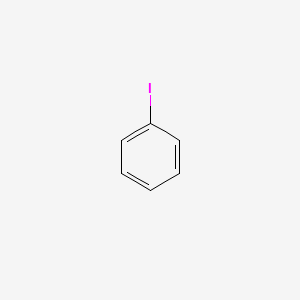



1. Iodobenzene, 123i-labeled
2. Iodobenzene, 125i-labeled
3. Iodobenzene, 14c-labeled
1. 591-50-4
2. Benzene, Iodo-
3. Phenyl Iodide
4. Benzene Iodide
5. Iodinebenzol
6. Iodo-benzene
7. Iodophenyl
8. 1-iodobenzene
9. Iodo Benzene
10. 4-iodobenzene
11. Mfcd00001029
12. 9hk5l7ybbr
13. Nsc-9244
14. Phenyliodide
15. C6h5i
16. Iodobenzene, 98%
17. Nsc 9244
18. Einecs 209-719-6
19. Unii-9hk5l7ybbr
20. Iodiobenzene
21. Iodobenezene
22. Phenyl-iodide
23. Ai3-16898
24. 3-iodobenzene
25. Benzene, Iodo
26. 2-iodo-benzene
27. Hsdb 7859
28. Phenyliodine(iii)
29. Iodobenzene [mi]
30. Iodobenzene [hsdb]
31. Schembl1587
32. Chembl116296
33. Dtxsid8060452
34. Nsc9244
35. Amy10020
36. Bcp22486
37. Str02365
38. Zinc1699878
39. Stl453620
40. Akos000118942
41. Cs-w008603
42. Db02252
43. Sb66617
44. Iodobenzene, Puriss., >=99.0% (gc)
45. Db-029918
46. Ft-0627260
47. Ft-0670366
48. I0050
49. D77691
50. A832185
51. Q420839
52. F1908-0074
| Molecular Weight | 204.01 g/mol |
|---|---|
| Molecular Formula | C6H5I |
| XLogP3 | 3.2 |
| Hydrogen Bond Donor Count | 0 |
| Hydrogen Bond Acceptor Count | 0 |
| Rotatable Bond Count | 0 |
| Exact Mass | 203.94360 g/mol |
| Monoisotopic Mass | 203.94360 g/mol |
| Topological Polar Surface Area | 0 Ų |
| Heavy Atom Count | 7 |
| Formal Charge | 0 |
| Complexity | 46.1 |
| Isotope Atom Count | 0 |
| Defined Atom Stereocenter Count | 0 |
| Undefined Atom Stereocenter Count | 0 |
| Defined Bond Stereocenter Count | 0 |
| Undefined Bond Stereocenter Count | 0 |
| Covalently Bonded Unit Count | 1 |
The monohydroxylation of halobenzenes by phenobarbital-induced rat liver microsomes was studied. p-Halophenol was the major metabolite from all 4 halobenzenes; o-halophenol formation decreased as the halogen atom size increased. Vmax for total hydroxylation (ortho and para products) correlated well with the sigma + Hammett constant with a negative rho value. This implied a positively charged intermediate in the rate-determining step. Vmax for either ortho or para hydroxylation alone did not correlate with a Hammett constant, implying that the product-determining step occurred after the rate-determining step. Rate-determining formation of a radical cation intermediate probably explained this data. /Halobenzenes/
PMID:6579552 Full text: https://www.ncbi.nlm.nih.gov/pmc/articles/PMC391234 Burka LT et al; Proc Natl Acad Sci USA 80 (21): 6680-4 (1983)
Detoxification of halogenobenzenes by sulfate, glucuronic-acid, and mercapturic-acid conjugation was studied. Chinchilla-rabbits received oral doses of chlorobenzene, bromobenzene, and iodobenzene equivalent to 150, 210, and 272 mg/kg, respectively ... Ethereal sulfates (E), glucuronides (G), and mercapturic-acids (M) were quantitated in rabbit urine. For chlorobenzene, the percentages of the dose excreted as conjugates were: G, 25.2; E, 26.6; and M, 20.4. For bromobenzene percentages were: G, 40.2; E, 36.8; M, 20.9. For iodobenzene, percentages were: G, 31.3; E, 29.6; M, 22.6 ...
Spencer B, Williams RT; Biochem J 47: 279-84 (1950)
Iodobenzene has a bimodal effect on the receptor cell tuned to benzoic acid (BA) of the female silk moth Bombyx mori. Exposure to iodobenzene causes an inhibition of the response to BA. With stimulation by iodobenzene alone, a reduction of basic nerve impulse firing during exposure is followed by a transient post-stimulus excitation (rebound). /It was suggested/ that inhibition suppresses excitation during exposure but fades afterwards more rapidly than excitation. Due to the spatial equivalence of the iodine and the acid residue, these effects might indicate opposing interactions of iodobenzene with the specific site for the key compound BA. This is supported by the fact that substitutions by smaller halogens are less effective in both inhibition and rebound ...
PMID:15901657 de Brito Sanchez MG, Kaissling KE; Chem Senses 30 (5): 435-42 (2005)